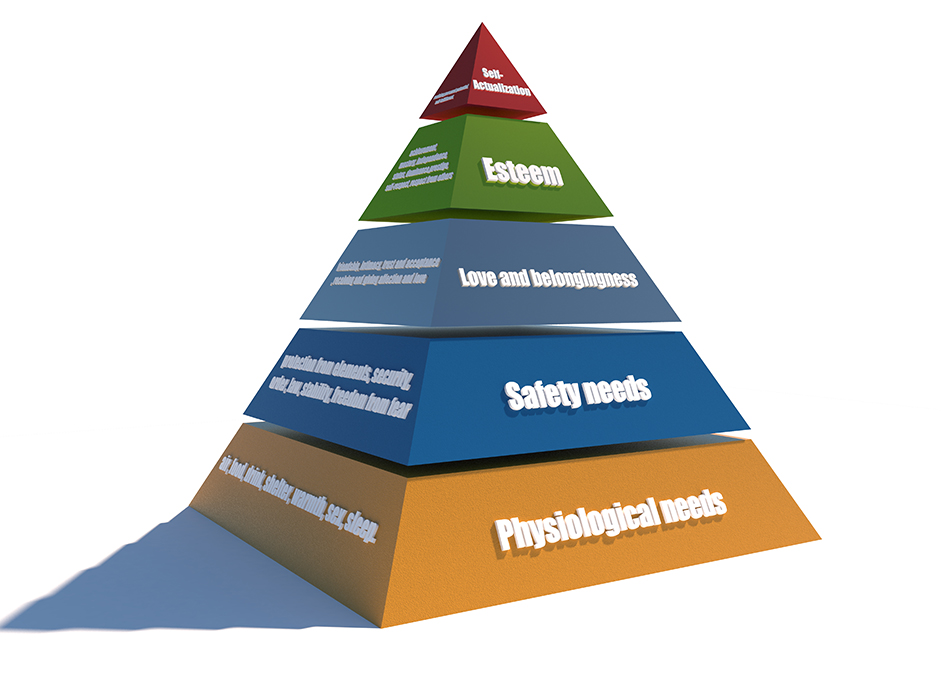Psychologist Abraham Maslow in 1943 introduced a concept that today can help guide how we run and promote our businesses to achieve greater success. It's still relevant in advertising psychology today.
You might remember Maslow’s “Theory of the Hierarchy of Needs” from your Psychology 101 class. It provides a method of organizing and prioritizing important areas of life and living, culminating in finding our purpose. It also turns out to be an excellent guide for people in business.
Maslow’s theory is best illustrated by a pyramid with the most basic needs at the bottom. They begin with such physiological needs as water, food, sleep and yes, sex. They are the foundation. You can move on to the next level only when those needs are met.
Next is safety — protection, including shelter, economic, health, property and anything that could harm us. Then comes social belonging, which includes our love of family and friends. We move up to the second rung from the top of the pyramid: esteem, the need for attention and respect.
The very top of the pyramid is self-actualization. This stage is characterized by looking outside of our self to our community and society for the greater good, our purpose.
In business, the importance of finding purpose has gained traction. Many refer to it as finding our “why.” Simon Sinek’s famous TED talk about finding our why produced an explosive 42 million views and counting. His talk helped us to see, feel and understand the “why” movement more clearly.
Employees want to work for companies with a “why.” It is the reason companies do what they do beyond making money. It’s wrapped around a higher purpose.
Our customers, too, want more out of our products or services. They want to know that there is a “why” behind them.
Your why could be healthier food for a healthier world. Or the use of recycled materials to reduce our carbon footprint or donating 10 percent of profits to feed the hungry in your community. You get the idea.
Millennials have come to symbolize the higher need for purpose. This also explains the increased desire for experiences over things — the Starbuck’s experience vs. Maxwell House coffee. Materialism alone no longer provides enough satisfaction.
Who moved the cheese?
Just behind the Millennials is the generation born starting around 1995, GenZ. They are purpose-driven even more than Millennials and are drawn to truth and authenticity.
GenZ makes up 25 percent of our population, more than Millennials or Baby Boomers, but they are not alone in clamoring for the “why.”
Those who came before the Millennials also are moving up the pyramid. They include GenX, the Baby Boomers and even the Greatest Generation from the World War II era.
People from all generations are making it to the top of Maslow’s pyramid. His 1943 theory is playing out. Funny how truths have long lives.
Good advertising psychology mirrors society.
Advertising trends are driven not only by the technological revolution; faster, better, cheaper. What might be an even bigger driver is this radical change in all of us. We don’t put up with as much crap. We want the truth. We want brand transparency.
More and more of us want to know we are dealing with a brand that stands for something good — or at least isn’t hurting our community or the world.
We are in a time of change.
To sustain and grow our businesses, we must adapt to the changing needs of our customers and society. In addition to the products and services we offer, we must find our why and align our business accordingly.
In some situations, this might involve a repositioning strategy — that is, adjusting existing perceptions about our brand in the minds of our prospects and customers to line up with our greater purpose, our why.
In other situations, your why might line up with your products and services without the need to reposition. It’s more about discovering the why that was already there and embracing and expressing it.
When you find your why, consider all the ways you can make adjustments throughout your organization. The result will be felt by everyone in and outside of your organization.
Thank you, Maslow, for shining the light on advertising psychology.



